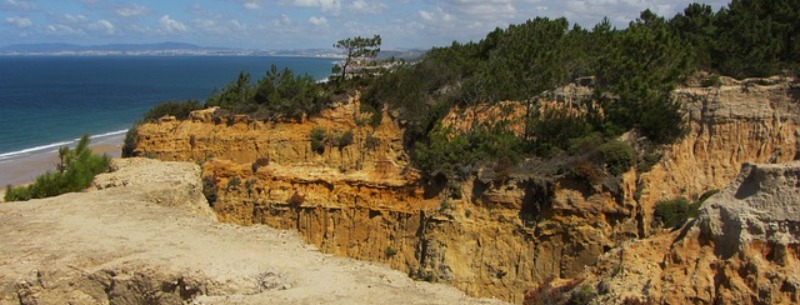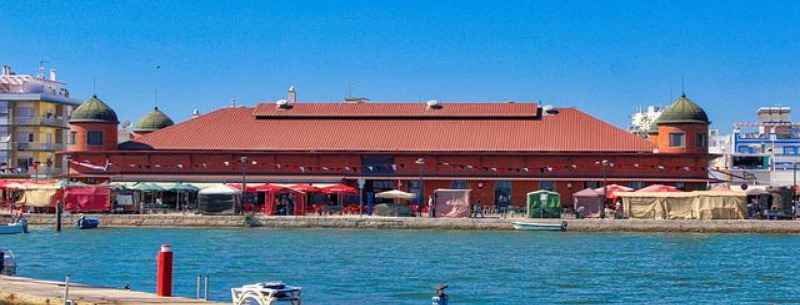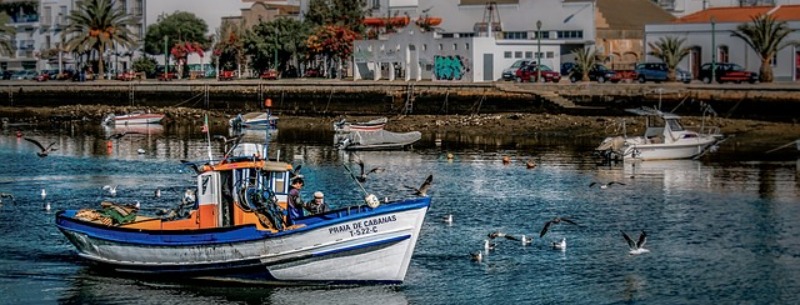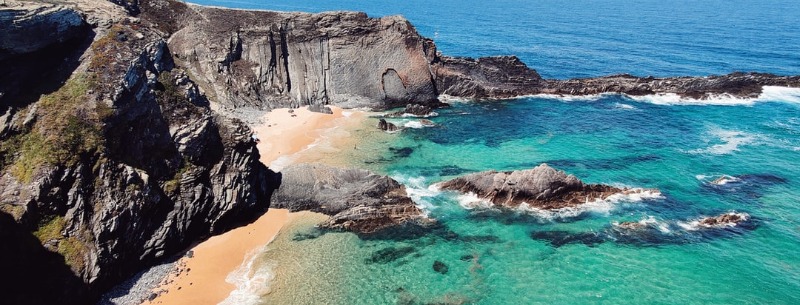Beach Destinations in Portugal 2024
Portugal is around the size of Scotland with twice the population and has tremendous variety both geographically and in its ways of life and traditions.
Along the coast around Lisbon, and on the well-developed Algarve in the south, there are highly sophisticated resorts, while the vibrant capital Lisbon has enough going on to please most city devotees.
What part of Portugal has the best beaches?
Portugal’s coast is a virtually continuous beach, and apart from the Algarve and a few pockets around Lisbon and Porto, resorts remain low-key and thoroughly Portuguese, with great stretches of deserted sands between them.
Perhaps the loveliest are along the northern Costa Verde, around Viana do Castelo, or, for isolation, the wild beaches of southern Alentejo.
Alentejo Coast
The coast south of Lisbon features towns and beaches as inviting as those of the Algarve. Admittedly, it’s exposed to the winds and waves of the Atlantic, and the waters are colder, but it’s fine for summer swimming and far quieter. Access is straightforward, with local bus services and the twice-daily Zambujeira Express from Lisbon, which takes you within easy range of the whole coastline and stops at the beaches of Vila Nova de Milfontes and Zambujeira do Mar.
Five buses a day run from Lisbon to Alcacer do Sal, from where there are reasonable connections south to Santiago Do Cacem, a pleasant little town overlooked by a castle. In turn, there are five buses a day (in summer) from Santiago to Lagoa de Santo Andre and the adjoining Lagoa de Melides, with two of the best beaches in the country. Each of these lagoons has its own small summer community entirely devoted to having a good time on the beach. The sea is enticing with high waves and good surf, but take local advice on water conditions, as the undertow can be fierce.
On the southern half of the Alentejo coast, Odemira is the main inland base. A quiet, unspoiled country town, it has an erratic bus service (8 daily) to the beach at Vila Nova de Milfontes and to Zambujeira do Mar (2 daily). Unless you’re camping, you’re unlikely to find anywhere to spend the night in these resorts from June to August, so it’s not a bad idea to stay in Odemira and take day trips to the seaside.
Vila Nova De Milfontes lies on the estuary of the River Mira, whose sandy banks gradually expand and merge into the coastline. This is generally the most crowded and popular resort in Alentejo, with lines of villas and hotels radiating from the center of the old village. It’s still a pretty place, though, with a handsome little castle and an ancient port, reputed to have harbored Hannibal and his Carthaginians during a storm.
At Zambujeira Do Mar, south of Odemira and 7km west of the main road, a large cliff provides a dramatic backdrop to the beach, more than compensating for the winds. Lastly, the resort of Porto Covo, although overdeveloped, has plentiful accommodation and beautiful, almost untouched beaches to the south.
Costa da Caparica
By car, it takes something over an hour to reach Costa da Caparica from the capital, and it’s here that most locals come if they want to swim or laze around on the sand.
This is a thoroughly Portuguese resort, popular with surfers and crammed with restaurants and beach cafes, yet solitude is easy enough to find, thanks to the mini-railway ( transpraia ) that runs along the 8km of dunes in summer.

The quickest and most enjoyable approach is to take a ferry from the Fluvial station by Praca do Comercio, or from Cais do Sodre, to Cacilhas, and then pick up the connecting bus from the dock where the boats come in. Alternatively, and more speedily, you can take the #52 or #53 bus direct to Caparica from the main Praca de Espanha terminal (metro Palhava).
At Caparica, buses either stop at a bus park by the beach or at the station five minutes back from the sands. From the latter, walk up to the main road, turn right and keep walking until you reach Praзa da Liberdade, the main square, where there’s a tourist office (Mon-Sat 9:30 am-1 pm & 2:30-6 pm, also Sun in summer), market, cinema, and banks.
There aren’t very many hotels in Caparica but buses run back to Lisbon/Cacilhas most of the day and night. Campsites, which range along the first few kilometers of the beach, are on the whole overcrowded and overpriced, but functional enough.
Beyond Caparica along the coast between Setubal and Sesimbra, you will find the National Park of Arrabida, set in a deep cove called Portinho da Arrabida, a nature-lover’s paradise and one of the most attractive beach areas in Portugal.
Faro Beach
Faro, a sleepy provincial town twenty years ago, now has all the facilities of a modern European town, with an attractive shopping area, some decent restaurants, and a “real” Portuguese feel in contrast to many nearby resorts.
Excellent beaches, too, are within easy reach, and in summer there’s quite a nightlife scene, as thousands of travelers pass through on their way to and from the airport, 6km west of the town.
Lagos Beach
Once a quiet little town, Lagos is now a thriving fishing port and market center as well as one of the most popular tourist destinations in the Algarve.
Within walking distance of some superb beaches, the town is also an interesting historical center.
To the east of Lagos is a splendid sweep of sand – Meia Prais – where there’s space even at the height of summer, while the promontory south is fringed by extravagantly eroded cliff faces that shelter a series of tiny cove beaches.
All are within easy walking distance of the old town, but the headland is now cut up by campsites, hotels, roads, and a multitude of tracks, and the beaches all tend to be overcrowded.
Of these Praia de Dona Ana is considered the most picturesque, though its crowds make the smaller coves of Praia do Pinhao, down a track just opposite the fire station, and Praia Camilo, a little further along, just as appealing.
Olhao
Olhao, 8km east of Faro, is the largest fishing port on the Algarve and an excellent base for visiting the sandbank islands ( ilhas ). Train and bus stations are near each other off the Avenida da Republica northeast of town.
Ferries leave for the Ilhas of Armona and Culatra from the jetty at the far end of Olhao’s municipal gardens, five minutes from the market. The service to Armona (June-Sept 9-14 daily; Oct-May 4 daily) drops you off at a long strip of holiday chalets and huts that stretches right across the island on either side of the main path.

On the ocean side, the beach disappears into the distance and a short walk will take you to totally deserted stretches of sand and dune. The beach facing the mainland is smaller and tends to get very crowded in summer, but the water here is always warm.
Boats to the more distant Ilha of Culatra are less frequent (4-7 daily; 35-45min.) and call first at unattractive Culatra town, then at Farol, an untidy village of holiday homes edged by beautiful beaches on the ocean side. Note that ferry services are drastically reduced outside July and August.
Tavira Beach
Tavira is a clear winner if you are looking for an urban base on the eastern stretch.
It’s a good-looking little town with superb island beaches within easy reach, yet despite ever-increasing visitors, it continues to make its living as a tuna-fishing port.

Buses pull up at the new terminal by the river, a two-minute walk from the central square, the Praca da Republica; the train station is 1km from the center of town, straight up the Rua da Liberdade.
Boats cross from Quatro Aguas (during winter dependent on the weather), 2km east of town, to the eastern end of the Ilha de Tavira, which stretches west almost as far as Fuzeta, some 14km away.
The beach is enormous, backed by dunes, and despite increasing development – a small chalet settlement, watersports, beach umbrellas, and half a dozen bar/restaurants facing the sea – it’s an enjoyable spot in which to hang out.
Tavira has some of the best areas for scuba diving in Portugal, check out the diving school at Pedras Del Rei.
